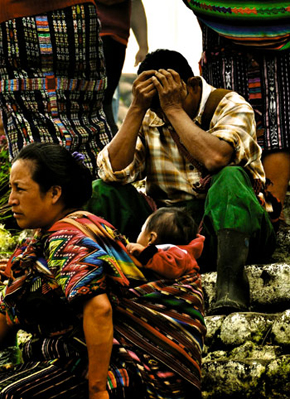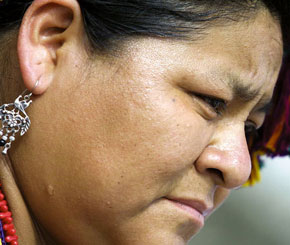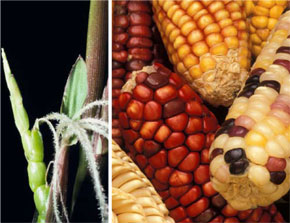
MARIO BOLLINIThe Mayas from Guatemala: one of the peoples that carry this mutationMARIO BOLLINI
The native peoples of the Americas and their descendants carry in their bodies a particular characteristic that distinguishes them from people in other continents. For almost 300 generations their cells have housed a genetic alteration that in the past allowed them to survive, but over the last 40 years has been contributing to ill health. The mutation, which an international team of researchers found in 29 indigenous American populations, especially those from Mexico and Central America, increases the energy reserve of cells and at times of plentiful calories favors the development of the health problems that are growing fastest in the world: obesity, diabetes and the cardiovascular diseases that kill 17 million people a year.
The genetic variation, so far only detected in contemporary American Indians and their descendants, affects a gene known as ABCA1 and leads to the exchange of one of the 140 million nucleotides (units that form the DNA) that are packaged in chromosome 9. Common in the organism, this type of alteration occurs thousands of times as the cells duplicate their genetic material before dividing and it is almost always corrected by cell repair mechanisms. When it escapes, it usually does not interfere in the body’s functioning.
That, however, is not the case with this fault in ABCA1. The substitution of a single nucleotide in this gene modifies the structure of a protein in the cell membrane that controls the level of cholesterol in the cells. As a result, the cells accumulate 30% more cholesterol, which enters into the composition of hormones and serves as an energy store.
“This is not the first alteration to be observed in this gene, nor the only characteristic of native Americans”, says Victor Acuña-Alonzo, a researcher at the National Institute of Archaeology and History (INAH), in Mexico, first author of the article that described the frequency of this mutation among Amerindians in July 2010’s Human Molecular Genetics. “But, as far as we know, it’s the first mutation, which in addition to being exclusive to these peoples, was selected by environmental conditions, spread throughout the continent and affects the functioning of the organism.”
A member of the team of biochemist, Samuel Canizales-Quinteros, who is studying the effects of this alteration on the Mexican population, Victor has been working with researchers from Brazil and other countries to map out this genetic variation on the continent. On his first visit to the country in 2008 he only had a sample of Mexican and Central American Indians. In the Federal University of Rio Grande do Sul he met geneticists Francisco Salzano and Maria Cátira Bortolini, who had genetic material taken from 5,000 South American Indians and they suggested collaborating with him. In the same year, Tábita Hünemeier, who was doing a PhD under the supervision of Maria Cátira, spent two months at Unam and then went to the laboratory of Andrés Ruiz-Linares, at University College London, where she mapped out the characteristics of the ABCA1 gene of Indians from the Andes and Canada.
Tábita, Victor and Teresa Flores Dorantes analyzed genetic information from 4,405 individuals from 38 indigenous American peoples and compared it with information taken from 863 members of the populations of Asia, Europe and Africa. They found that the genetic alteration in ABCA1 that leads to the substitution of an arginine amino acid by a cysteine does not exist on other continents – at least not in the groups studied – and affects, on average, 15% of native Americans. However, its frequency varies a lot. No individual from the Seri people of northwest Mexico had the alteration, which is found in 29% of the Cora Indians, 21% of the Zapotecas and 20% of the Mayas in Mesoamerica. In South America, the mutation was not detected among the Jamamandis and the Karitianas, from the Amazon, or the Mapuches, from Chile and Argentina, but it is common among the Xavantes (31%), from Mato Grosso.

AFPNobel prize winner, Rigoberta Menchú, a descendent of the MayasAFP
Despite differences there is a pattern in the data: the distribution of this genetic variation is more homogenous in Mexico and Central America, low in the Andes and oscillates in the lowest lying lands in South America, where Brazil is located. In the article in Human Molecular Genetics, the researchers offer two explanations for this.
The first is that the mutation must have favored the survival of individuals because its effect was to protect them against infectious diseases. Viruses like yellow fever and dengue fever or the parasite that causes malaria seem to need cholesterol for invading the organism and reproducing. They would be adversely affected by this alteration in the ABCA1 gene. Experiments by Canizales’ team showed that cells with the altered form of the gene liberate 30% less cholesterol into the bloodstream. With less cholesterol at the disposal of the infectious agents, more people would survive and would transmit the altered gene to future generations. One fact supports this idea: the peoples in whom the mutation in the ABCA1 gene is most common live in regions with the greatest incidence of these infections.
Tábita and Maria Cátira, who have signed another, as yet unpublished article with Victor and Canizales, believe more in a second explanation, the so-called frugal gene hypothesis. According to this theory, proposed in 1962 by North American geneticist, James Neel, genetic characteristics that prove to be advantageous in some way would be maintained in a population. In the language of biologists, they would go through a process of positive selection. In this case, the reduction in cholesterol flow out of the cells would imply a greater accumulation of energy, which is fundamental in periods of food scarcity, like those which the first inhabitants of America – and other parts of the globe – must have frequently faced before agriculture became stabilized and animals were domesticated.
The domestication of corn is seen by the “gaucho” researchers as being the probable factor that acted as the catalyst for the dispersion of this altered form of ABCA1 in the Amerindian population, especially in Mesoamerica. Recent archaeological data indicate that the wild ancestor of corn, a grass called teosinte, which produces legumes like those of the peanut, started being cultivated 8,700 years ago in the River Balsas valley, in southern Mexico. Stone artifacts and corn microfossils, which it is estimated had been the source of 70% of the calories consumed by the peoples of Mesoamerica and is still the basis of the region’s diet, have been found there.
Analyzing the alterations surrounding the ABCA1 gene, Tábita and Maria Cátira estimate that the variant that favors the accumulation of cholesterol in the cells appeared 8,300 years ago, almost 10,000 years after the first human beings arrived in America (see text on “Like our parents”).

MATT LAVIN / MONTANA STATE UNIVERSITY (TEOSINTE) AND USDATeosinte, above: wild ancestor of cornMATT LAVIN / MONTANA STATE UNIVERSITY (TEOSINTE) AND USDA
This date coincides with that of the domestication of corn and strengthens the idea that the cereal may have contributed to the positive selection of this mutation. In the opinion of John Doebley, from the University of Wisconsin, an academic working on the domestication of corn, it is reasonable to think that the start of agriculture in America had an influence on the selection of the mutated form of ABCA1, just as milk consumption and the domestication of cattle led to an increase in the frequency of the genetic variant in Europe and Africa that allows adults to digest lactose.
However, how did what had been an evolutionary advantage in the past remain as such after agriculture began? It is probable. The researchers imagine that, having identified corn as a food and learned how to plant it, the Indians became sedentary and the population multiplied. Christopher Gignoux, from the University of Stanford, used the genetic data of people that practiced agriculture and groups of hunter-collectors to estimate the pace of population growth. In a study to be published in the journal, PNAS, he concludes that the rise of agriculture increased the growth rate of populations in Europe, Asia and Africa by five times.
Groups that had before consisted of dozens of people started sheltering thousands. The number of arms for producing and mouths to feed grew. “Imagine that agriculture was only partially successful in the beginning,” says Maria Cátira. Archaeological information (the degree of malnutrition calculated by analyzing the teeth and bones) suggests that periods of famine (and high mortality) were frequent in the first few thousand years before production became stable.
Only those who managed to store energy and support their hunger for longer would be capable of getting through these periods. “In times like these up to 80% of the people who survived were likely to be carriers of at least one copy of the altered form of the ABCA1 gene,” calculates Tábita. If the hypothesis that the domestication of corn contributed to spreading the mutation in America is proved to be correct, this will be the first recorded case of natural selection being influenced by agriculture among native American peoples. However, for the time being it is only hypothesis. The researcher’s only conviction is that in Mexico and Central America dispersion of the altered gene did not happen by accident. In South America, on the other hand, it might have been different, since corn did not have the same importance, nor is there consistent evidence of large population groups having existed.
Whatever the explanation, it is certain that the factor that allowed people to get through times of hunger today adversely affects the health of Amerindians. Canizales and his team showed that years ago this alteration in ABCA1, found in 20% of the Mexican population, is more common among obese people, who have diabetes and abnormal levels of cholesterol (dyslipidemia). They also noted that it contributes to obesity, diabetes and dyslipidemia, all risk factors for cardiovascular problems. On crosschecking genetic data with information about height, weight and lipid and sugar levels of 1,729 people, the group saw that among the known alterations of ABCA1, the mutation that leads to the exchange of arginine for cysteine is the one that contributes most to reducing HDL levels, the most common form of dyslipidemia in Mexico.
“Although apparently absent from other populations these mutations, which are typical of specific groups, may have an important functional effect, in this case on the metabolism”, explains geneticist Carla D’Angelo, from the University of São Paulo. “As the alteration is shared by other people from America, I believe that it may have an influence on the health of people in Ecuador, Peru and Bolivia, where the indigenous component of the population is large,” says Victor. “From now on,” says Maria Cátira, “it’s no longer possible to comprehend the metabolic problems of the native peoples of the Americas without considering the role played by this genetic alteration.”
Republish